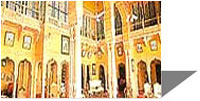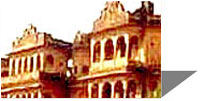Shekhawati has produced the maximum number of millionaires and billionaires in India! The wealthy merchants of this region popularly known as Marwaris are spread all over the world but still own their ancestral mansions (havelis) in their native villages and towns. The five great deeds a marwari merchant is supposed to do are to build a haveli, a well, a school, a dharamshala (Caravanserai) and a temple. T he merchants, flushed with money, competed with each other in building such structures. 
In spite of being this exotic visual treat, Shekhawati, for some strange reason, did not figure in the tourist itinerary until the early 80s. Important guide books like Eustace Reyolds-Ball's The Tourist's India (1907) and Nagel's more ambitious India: Encyclopaedia-Guide (1977) conveniently left out this paradise of paintings. It was only after Francis Wacziarg's and Aman Nath's discovery that Shekhawati began to be taken seriously. Wacziarg is a French businessman and an Indophile, while his friend Aman Nath a writer and graphic designer. In their peregrinations through the country, the two young men had stumbled upon the Shekhawati frescoes and decided to expose them in a photographic essay, The Painted
Walls of Shekhawati (1982). It was only after that Shekhawati began getting the attention it so much deserves.
History
In the 16th-17th centuries, Rajasthan stood divided into five large and several smaller kingdoms. The five were Amber (Jaipur), Bikaner, Jaisalmer, Jodhpur (Marwar) and Udaipur (Mewar). The first two kingdoms shared the region which was destined to become so rich in murals. The founder of this beauteous Shekhawati was the Rajput, Rao Shekha, a descendent of the illustrious Kachhawaha family who held Amber-Jaipur for centuries. The chieftains of Shekhawati were the descendants of Baloji, the third son of Raja Udaikaran, who succeeded to the throne of Amber in 1389.
Places of Interest
The open art gallery
The semidesert region of Shekhawati is a colourful fantasy having fascination uniquely of is own. 'The open air-art-gallery', as it is popularly called, is famous for its plethora of painted havelis, all commendable pieces of the rich artistic tradition of this region. 'Shekhawati', meaning "the land of Shekha's clan" derives its name from Rao Shekha (1433 AD-1488 AD) a scion of the Kachhwaha family of Jaipur. Earlier a part of the former Jaipur state, it now comprises of the districts of Jhunjhunu and Sikar. Initially the region had a blank monochromatic look but with subsequent historical and social developments it has blossomed into a colourful profusion of art and life for almost 2 centuries from 1750 AD to 1930 AD.
Havelis
Although the region has lost its importance as a centre of trade, its importance today lies in the splendidly frescoed havelis or mansions- mostly constructed by the prosperous merchants, between the 18th and 20th centuries. The area being arid and opportunities being limited locally, enterprising men moved out to carve niches for themselves in business. Today the splendidly painted walls of the people of Shekhawati.
Dundlod 
This quaint is in the heart of the Shekhawati region. The fort here dates back to 1750. Steps lead up to the Diwan Khana furnished with portraits, hangings and period furniture. It also houses a library and portraits done in European style can be seen here. The fort has now been converted into a hotel. The Goenka havelis and other with beautiful frescoes
Sikar
Sikar was the wealthiest thikana (feudatory) under the Jaipur state. The 17th century fort here, was built when Sikar was an important trading centre. Sites worth visiting here are the market, the clock tower and the painted Biyani, Murarka and Somani havelis. There is one Haveli Painted only in blue, quite like the typical Chinese blue and are the Sagarmal Sodhani Haveli, Madho Niwas Kothi, the Jubilee Hall and the Fort. The Jain temple as also the temples of Gopinath and Raghunath and Madan Mohan deserve a visit. In the neighborhood lie the Jeen Mata temple and harsh Nath temple.
Harsh Nath Temple (11 km)
An ancient 10th century temples situated on the Harsh Nath hills.
Jeen Mata Temple (29 km) Believed to have been built a thousand years ago the temple is the venue of a colourful fair held twice in a year during `Navaratras'.
Rambagh
Founded in the late 18th century by the Poddars. The Shani Temple of the Saturday God has delicately painted frescoes. Marvelous cenotaphs of the Poddars have exquisitely painted ceilings. The Ganga Temple and some beautiful havelis add interest to the town.
Lachhmangarh Fort
One of the most imposing forts in the Shekhawati region, Lachhmangarh commands a bird's eye view of the town modeled to resemble the city plan of Jaipur. Founded in the early 19th century by Raja Lachhman Singh of Sikar, the town has some lovely havelis.
Shekhawati is named after its ruler Rao Shekha of the 15th century. Strategically placed on the route between ports of Gujarat and Northern India, the region became very prosperous by imposing levies on the caravans of traders passing through. When the region's fortunes fell after the development of new ports like Bombay and Calcutta, the merchants migrated en masse and quickly re-established themselves. They continued to send their huge incomes back in their villages thus continuing their constructive passions.
Prominent towns of the region are Nawalgarh, Mandawa, Mahansar, Mukundgarh, Lachhmangarh, Singhana, Parsrampura, Khetri, Baggar and Jhunjhunu. The continuity of havelis and quietness of the towns suggest bicycle tour as the most ideal way of sightseeing. A few farm retreats have also recently come up with the idea of an eco-friendly stay. Tal Chhapar Sanctuary is a good excursion point; the sanctuary has an overwhelming population of Blackbucks.
How to Reach
- Air
Jaipur is the nearest airport, 120 km away from shekhawati.
- Train
Mainline railway joining Delhi, Jaipur,Bikaner crosses Shekhawati
- Road
Shekhawati is 120 km by road from Jaipur. THis is the most convenient way to tour Shekhawati and surrounding areas.
|